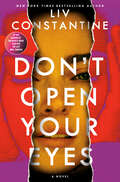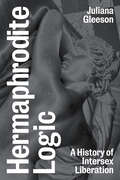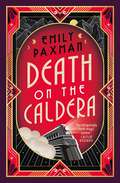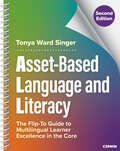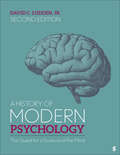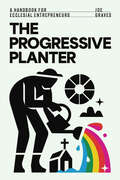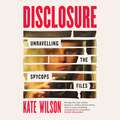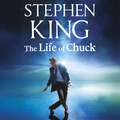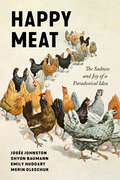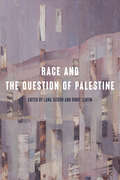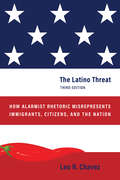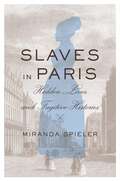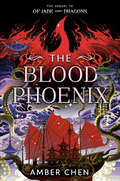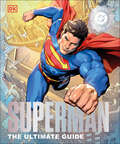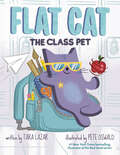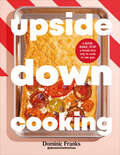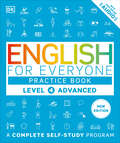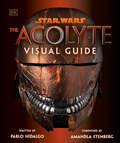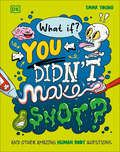- Table View
- List View
Don't Open Your Eyes: A Novel
by Liv ConstantineIn this twisted psychological thriller from the New York Times bestselling co-author of the Reese&’s Book Club pick The Last Mrs. Parrish, a woman is tormented by nightmarish visions of her future—and then they start to come true.&“A compulsively readable nail-biter.&”—Kimberly McCreight, New York Times bestselling author of Like Mother, Like Daughter &“Psychological thriller lovers are in for a darkly delicious treat.&”—Carola Lovering, author of Tell Me LiesAnnabelle Reynolds has everything she&’s ever wanted. A devoted husband, two wonderful daughters, and a career she loves. She couldn&’t be happier. So why is she suddenly plagued by disturbing dreams of a future where she hates her husband and her daughters&’ lives are at risk? At first, she chalks the dreams up to an overactive imagination. But when details from her dreams, details she couldn&’t possibly have predicted, begin to materialize, she realizes these aren&’t just dreams but rather premonitions of a terrifying future. They all point to a singular choice, an unknown moment that holds Annabelle&’s life in the balance.Then Annabelle has a dream that her daughter Scarlett is in immediate danger. Someone wants Scarlett dead, and Annabelle has no idea who or why. Suddenly, every choice she makes is fraught with peril, with no inkling of which move could bring this terrifying vision to life. As Annabelle&’s present life starts to collide with the future in her dreams, she wrestles with how much control she really has over her destiny and whether she can change what is meant to be.
Hermaphrodite Logic: A History of Intersex Liberation
by Juliana GleesonHow the intersex liberation movement exposed medical harms and became an inspiration to rethink sex and genderHERMAPHRODITE LOGIC is a bold examination of intersex liberation. Juliana Gleeson reveals how a move-ment challenged systemic medical abuses to reshape our understanding of sex. Blending philosophical insights and personal testimonies, Gleeson argues that intersex people have been harmed not just for therapeutic reasons but to ease professional andparental anxieties.
Death on the Caldera
by Emily PaxmanIt&’s Murder on the Orient Express – with witches! A thrilling blend of fantasy and classic murder mystery, this rollicking adventure with a wide cast of suspects is ideal for those who love both Agatha Christie and V. E. Schwab, and are drawn to stories that take place in a vivid fantasy world.The Linde siblings—Kellen, Davina, and Morel—are anxious to return to the kingdom of Halgyr before their father dies, leaving Kellen to assume the throne as king. They book tickets on a luxury express train, expecting a swift journey home—but disaster strikes when the train engine explodes, stranding the siblings atop a caldera bubbling with volcanic magic.The crash triggers Davina&’s latent witch powers, but her magic disrupts her ability to remember what she was doing when the explosion took place. While a witch would be the prime suspect for the catastrophe, the only ones who knew Davina might become one are her brothers—who never warned her. And, to add insult to injury, somebody is bumping off the surviving train crew and passengers. But it can&’t be Davina, can it?While the remaining passengers try to determine who sabotaged the engine and catch the killer, the fractured siblings attempt to stay one step ahead, concealing not only Davina&’s powers but their own secrets. Luckily, they aren&’t the only shifty characters on the train…A thrilling blend of classic murder mystery and fantasy for those who love Murder on the Orient Express and Death on the Nile every bit as much as Fourth Wing and A Court of Thorns and Roses.
Asset-Based Language and Literacy: The Flip-To Guide to Multilingual Learner Excellence in the Core
by Tonya W. SingerEnsure multilingual learners thrive in every classroom, every day. Asset-Based Language and Literacy is the essential guide for K–12 teachers to ensure all students—including multilingual learners (MLs)—thrive with the rigorous content literacy and language demands of school. Building on the proven pedagogy and practical flip-to format of the best-selling first edition, Tonya Ward Singer offers essential updates that help educators center ML assets and deepen collaborative inquiry to ensure MLs belong and thrive in every classroom, every day. The user-friendly flip-to format and color-coded resources help busy teachers find exactly what they need when they need it. Popular features include: Practical strategies for scaffolding language, concepts, and academic literacy in your daily lessons Differentiation guides for personalizing instruction to students’ assets and learning priorities Effective teaching routines to strengthen student conversations, close reading, and rigorous writing. The Six Essentials framework to help teachers, co-teachers, and teams deepen their impact with MLs and all students. Asset-Based Language and Literacy equips educators with confidence and tools to create high-challenge, high-support learning environments to ensure all students thrive. With a focus on practical research-based strategies, this is your go-to guide for building collective efficacy for every teacher to be an ML teacher!
Asset-Based Language and Literacy: The Flip-To Guide to Multilingual Learner Excellence in the Core
by Tonya W. SingerEnsure multilingual learners thrive in every classroom, every day. Asset-Based Language and Literacy is the essential guide for K–12 teachers to ensure all students—including multilingual learners (MLs)—thrive with the rigorous content literacy and language demands of school. Building on the proven pedagogy and practical flip-to format of the best-selling first edition, Tonya Ward Singer offers essential updates that help educators center ML assets and deepen collaborative inquiry to ensure MLs belong and thrive in every classroom, every day. The user-friendly flip-to format and color-coded resources help busy teachers find exactly what they need when they need it. Popular features include: Practical strategies for scaffolding language, concepts, and academic literacy in your daily lessons Differentiation guides for personalizing instruction to students’ assets and learning priorities Effective teaching routines to strengthen student conversations, close reading, and rigorous writing. The Six Essentials framework to help teachers, co-teachers, and teams deepen their impact with MLs and all students. Asset-Based Language and Literacy equips educators with confidence and tools to create high-challenge, high-support learning environments to ensure all students thrive. With a focus on practical research-based strategies, this is your go-to guide for building collective efficacy for every teacher to be an ML teacher!
Every Child Deserves a Special Education: Five Mindframes That Ensure All Students Learn
by Douglas Fisher Nancy Frey Lorraine Graham John Hattie Lee Ann JungLay the foundation for inclusive, impactful classrooms where every student thrives Every student deserves an education that is meaningful, memorable, and built for them. When we design learning with intentional, universal support, the impact extends beyond individual students—it transforms entire classrooms. In Every Child Deserves a Special Education, the authors introduce five powerful mindframes that reshape the way we think about teaching, learning, and inclusion. These mindframes spark a cycle of reflection and growth, shifting not just what we do, but how we see our students, our classrooms, and our role as educators. Inside, you’ll find: Five essential educator mindframes—helping you plan for both diverse learners and the diversity within each learner Stories and examples that bring these mindframes to life through real classroom experiences Reflection tools to help you examine and refine your own beliefs and practices True inclusion starts with how we think, not just what we do. Every Child Deserves a Special Education will help you build the mindset every classroom needs for all students to thrive.
A History of Modern Psychology: The Quest for a Science of the Mind
by David LuddenA History of Modern Psychology: The Quest for a Science of the Mind describes the evolution of psychology into the twenty-first century with coverage of recent events and findings that transform our understanding of the past. With a topical approach that presents key thinkers within the context of schools of thought, students are able to see how philosophers, researchers, and academics influenced one another to create the rich and diverse landscape of modern psychology in a global context. In the new Second Edition, the author expands coverage of unsung pioneers (philosopher Al-Balkhi, zoologist Charles Henry Turner, psychiatrist Grunya Sukhareva, and others), revisits the legacy of Francis Galton, explores the "Vygotsky boom," and includes new discussion of the impact of Philip Zimbardo′s Stanford Prison Experiment. Through detailed timelines and features such as "Looking Back" and "Looking Ahead," Ludden gives students a deeper appreciation for the transference of knowledge that shaped the field.
A History of Modern Psychology: The Quest for a Science of the Mind
by David LuddenA History of Modern Psychology: The Quest for a Science of the Mind describes the evolution of psychology into the twenty-first century with coverage of recent events and findings that transform our understanding of the past. With a topical approach that presents key thinkers within the context of schools of thought, students are able to see how philosophers, researchers, and academics influenced one another to create the rich and diverse landscape of modern psychology in a global context. In the new Second Edition, the author expands coverage of unsung pioneers (philosopher Al-Balkhi, zoologist Charles Henry Turner, psychiatrist Grunya Sukhareva, and others), revisits the legacy of Francis Galton, explores the "Vygotsky boom," and includes new discussion of the impact of Philip Zimbardo′s Stanford Prison Experiment. Through detailed timelines and features such as "Looking Back" and "Looking Ahead," Ludden gives students a deeper appreciation for the transference of knowledge that shaped the field.
The Progressive Planter: A Handbook for Ecclesial Entrepreneurs
by Joe GravesDiscover how to launch an inclusive Church for today’s world.Equip new church start pastors, sending churches and denominational leaders with the essential tools to establish an inclusive, theologically healthy church that will impact its community. Learn about crafting a vision, recruiting leaders, working with parent churches and denominations, marketing, reclaiming evangelism, and cultivating generous givers.With the purchase of The Progressive Planter, you will receive access to supplemental digital download templates and tools for starting a church, including a board manual, job descriptions, core values, surveys, prayer guides, and more.
Disclosure: Unravelling the Spycops Files
by Kate Wilson'It was exciting when it started, then comfortable and domestic, and over time we grew apart. If it had been real, our relationship wouldn't have made a chapter in a memoir. But Mark was a fictional character, contrived by the British state to violate me and undermine the values I held dearest. And the entire time, EN31 was sitting around the corner, writing it all down, watching our lives unfold.'In 2003, British police infiltrated a group of idealistic young environmental activists, forming sexual relationships and spying without warrant on hundreds of innocent civilians.Kate Wilson fought back. She took the Met to court, at times battling alone without funding or legal representation, enduring bullying, psychological intrusion and further state surveillance. It took her nearly twenty years to uncover the eerie truth about Britain' s secret political police.In her own words, and those of the officers who documented her every move, this is Kate's story.
Someone Knows: A gripping thriller with a twist you'll never guess
by Vi KeelandFrom the No. 1 New York Times bestselling author Vi Keeland comes a twisty and addictive thriller.As a college English professor, Elizabeth looks forward to the start of each new semester teaching her creative writing seminar. At least until she reads chapter one of The Reckoning, a tale about a high school senior who has an affair with her teacher. To anyone else it would be the beginning of a great page-turner, but to Elizabeth it is the beginning of the end.She knows this story. It's all familiar because she lived it. The girl in the story was her best friend Jocelyn, and Elizabeth knows exactly how the story will end-with the professor dead. Because she was the one who killed him.Someone knows what Elizabeth did twenty years ago and her secret is about to be exposed, but who is the mystery student submitting the chapters? In an effort to find out, Elizabeth returns to her Louisiana hometown where it soon becomes clear that no matter how many years have gone by, she can't escape her past. What readers and authors love about Vi Keeland's thrillers . . . 'Keeland keeps the twists coming hard and fast, and few readers will be able to predict them' Publishers Weekly'Weaves a delicious web of grief, sex and obsession that will leave you guessing until the very end' Elle Kennedy, New York Times bestselling author 'I loved it! Wow, that ending! A sizzling ride down a dark path, with a twist that you won't see coming' Sarina Bowen, USA Today bestselling author'It's not often that a thriller leaves me speechless . . . the story is seductive in a forbidden way, sexy dark and alluring' READER REVIEW'I've read some really good books lately but it's been a while since I came across one that grabbed me by the scruff of the neck and wouldn't let me go . . . I could've stayed up all night reading' READER REVIEW 'This book is the perfect cure for any reading slump! It's intense, emotional, and twisted in all the right ways' READER REVIEW'5 glorious stars because that's the highest option, but this is one of those novels that deserves more!' READER REVIEW
Bug Hollow
by Michelle Huneven'I adored it' Claire Lombardo'Feels like watching a master painter at work' Ann Napolitano'I inhaled this book in a weekend' Leslie JamisonSummer, California, 1970s.Sally Samuelson is eight years old and the course of her family's life is about to change. When her golden-boy brother Ellis, just graduated from high school, drives up the coast with his two best friends, he promises to be back in a week. But he does not return. After Ellis's unexpected death, the world of the Samuelsons never spins on the same axis again - especially after Julia, Ellis's girlfriend, shows up pregnant on their doorstep. And over the next four decades, the family fractures and rebuild, again and again - in a story that takes in love affairs, illnesses, late-in-life marriages and long-hidden secrets, and shows how brief intimate connections and heart-shattering losses can reverberate through generations.
When Sleeping Women Wake: a sweeping historical WW2 novel with female resistance at its heart
by Emma Pei Yin'A heart-breaking, moving, and soaring novel. An important literary feat from an exciting new voice' NGUYỄN PHAN QUẾ MAI, global best-selling author of The Mountains Sing and Dust ChildHong Kong, 1941. Following the Japanese occupation of Shanghai, the wealthy Tang family flee to Hong Kong.As the First Wife of the family, Mingzhu leads a sheltered - if lonely - existence overseeing her daughter Qiang and managing the household alongside her devoted maid, Biyu.But when the Japanese army invade, the three women are scattered. Mingzhu is coerced into working for a Japanese captain. Qiang and Biyu escape the island, only to be forced into factory work then separated after an encounter with the East River Column Resistance fighters.The longer the brutal occupation lasts, the more determined the women are to resist. And as war rages around the world, each is holding onto the hope that the other is alive.Beautifully told and compulsively written, When Sleeping Women Wake is an utterly transporting story of female resistance and untold bravery, at once epic and intimate, heartbreaking and hopeful.Perfect for fans of Lisa See, Nguyễn Phan Quế Mai and Kristin Hannah.'A lushly romantic and impassioned story of women's agency and resilience' JUHEA KIM'Compelling, beautiful, and deeply moving . . . [a] stunning tale of love, loyalty and survival' WEINA DAI RANDEL'A breathtaking, important story of family, love and endurance . . . historical fiction at its finest' WIZ WHARTON
The Life of Chuck: soon to be a major film
by Stephen KingStephen King's 'The Life of Chuck' is a 'phenomenal' (USA Today) tale of life and legacy - and now a feature film directed by Mike Flanagan and starring Tom Hiddleston, Mark Hamill, Chiwetel Ejiofor, and Karen Gillan out in the UK from August 2025. Available for the first time in a beautiful standalone edition in June.Originally featured in the acclaimed story collection If It Bleeds, this unforgettable, mind-bending tale unfolds in reverse, taking readers through the extraordinary life of Charles 'Chuck' Krantz.In a crumbling world plagued by natural disasters, collapsing infrastructure, and mass panic, bizarre billboards and advertisements appear throughout town: 'Charles Krantz. Thirty-nine great years. Thanks, Chuck!' Marty Anderson, a schoolteacher, becomes obsessed with these messages as the world, inexplicably linked to Chuck's life, seems to be approaching its end.Told in three acts, presented in reverse order, The Life of Chuck explores one man's past. We see him in middle age on a business trip in Boston as he is seduced by a busker into spinning a gorgeous sidewalk dance. And we see him as a child, in a house haunted by a terrible secret, learning to dance with his grandmother. In these pages King reminds us that life's quotidian pleasures are even more glorious because they are fleeting: the outrageous good fortune of a beautiful blue day after a string of gray ones; the delight of dancing when every move feels perfect; a serendipitous meeting. King's ability to describe pure joy rivals his ability to terrify us.Now a major motion picture and winner of the Toronto International Film Festival People's Choice Award, The Life of Chuck is a glorious story about community and about humanity at its best, a celebration of joy, mystery, existential wonder, and the multitudes contained in all of us.
Happy Meat: The Sadness and Joy of a Paradoxical Idea (Culture and Economic Life)
by Josee Johnston Shyon Baumann Emily Huddart Kennedy Merin OleschukNorth Americans love eating meat. Despite the increased awareness of the meat industry's harms–violence against animals, health problems, and associations with environmental degradation–the rate of meat eating hasn't changed significantly in recent years. Instead, what has emerged is an uncomfortable paradox: a need to square one's values with the behaviors that contradict those values. Using a large-scale, multidimensional, and original dataset, Happy Meat explores the thoughts and emotions that underpin our moral decision-making in this meat paradox. Conscientious meat-eaters turn to the notion of "happy meat" to make sense of their behaviors by consuming meat they see as more healthy, ethical, and sustainable. Happy meat might be labeled grass fed, free-range, antibiotic free, naturally raised, or humane. The people who produce and consume it, together, make up the complex landscape of conscientious meat-eating in modern Western societies. The discourse of happy meat ultimately may not be a sufficient response to all the critiques of meat eating, rife as it is with contradictions. However, it offers a powerful case for understanding how moral boundaries and notions of the 'good eater' are constructed through negotiations of values, identity, and status.
Race and the Question of Palestine (Stanford Studies in Middle Eastern and Islamic Societies and Cultures)
by Lana Tatour and Ronit LentinThis book develops from the position that the colonization of Palestine—like other imperial and settler colonial projects—cannot be understood outside the grammar of race. Race and the Question of Palestine explores how race operates as a technology of power and colonial rule, a political and economic structure, a set of legal and discursive practices, and a classificatory system. Offering a wide-ranging set of essays by historians, legal scholars, political scientists, sociologists, literary scholars, and race critical theorists, this collection illuminates how race should be understood in terms of its political work, and not as an identity category interchangeable with ethnicity, culture, or nationalism. Essays build on a long-standing tradition of theorizing race in Palestine studies and speak to four interconnected themes—the politics of racialization and regimes of race, racism and antiracism, race and capital accumulation, and Black–Palestinian solidarity. These engagements challenge the exceptionalism of the Palestinian case, and stress the importance of locating Palestine within global histories and present politics of imperialism, settler colonialism, capitalism, and heteropatriarchy. Contributors: Yasmeen Abu-Laban, Seraj Assi, Abigail B. Bakan, Zvi Ben-Dor Benite, Yinon Cohen, Noura Erakat, Michael R. Fischbach, Neve Gordon, Alana Lentin, David Palumbo-Liu, John Reynolds, Kieron Turner
The Latino Threat: How Alarmist Rhetoric Misrepresents Immigrants, Citizens, and the Nation, Third Edition
by Leo R. ChavezNews media and pundits too frequently perpetuate the notion that Latinos, both US-born and immigrants, are an invading force bent on destroying the American way of life. Leo R. Chavez challenges the basic tenets of this assumption and other myths of the "Latino threat," providing a critical investigation into the fears and prejudices that are used to malign an entire population. In this updated and expanded third edition of his groundbreaking book, Chavez incorporates Donald Trump's emergence in American political life, with particular focus on the US-Mexico border as a site of political theater and the further sharpening of anti-Latino and anti-immigration rhetoric in public discourse. He also includes new discussions of "anchor babies," Dreamers and DACA, Latina reproduction and white replacement theory, and the emotional and psychological effects of negative political rhetoric on those whom it targets. Through trenchant analysis, this book reexamines urgent questions about what it means to be American.
Slaves in Paris: Hidden Lives and Fugitive Histories
by Miranda SpielerA pioneering biographical study of enslaved people and their struggle for freedom in prerevolutionary Paris, by an award-winning historian of France and the French Empire.In the decades leading up to the French Revolution, when Paris was celebrated as an oasis of liberty, slaves fled there, hoping to be freed. They pictured Paris as a refuge from France’s notorious slave-trading ports.The French were late to the slave trade, but they dominated the global market in enslaved people by the late 1780s. This explosive growth transformed Paris, the cultural capital of the Enlightenment, into a dangerous place for people in bondage. Those seeking freedom in Paris faced manhunts, arrest, and deportation. Some put their faith in lawyers, believing the city’s courts would free them. Examining the lives of those whose dashed hopes and creative persistence capture the spirit of the era, Miranda Spieler brings to light a hidden story of slavery and the struggle for freedom.Fugitive slaves collided with spying networks, nosy neighbors, and overlapping judicial authorities. Their clandestine lives left a paper trail. In a feat of historical detective work, Spieler retraces their steps and brings to light the new racialized legal culture that permeated every aspect of everyday life. She pieces together vivid, granular portraits of men, women, and children who came from Africa, the Caribbean, and the Indian Ocean. We learn of their strategies and hiding places, their family histories and relationships to well-known Enlightenment figures. Slaves in Paris is a history of hunted people. It is also a tribute to their resilience.
The Blood Phoenix (OF JADE AND DRAGONS)
by Amber ChenThe sequel to Of Jade and Dragons, a thrilling and epic silkpunk fantasy inspired by the legendary Qing dynasty. Perfect for fans of Elizabeth Lim and Xiran Jay Zhao.Two years after Ying leaves the Engineer&’s Guild and the ghost of her father&’s unjust death behind, life seems to regain a semblance of normalcy. But the winds of unrest continue to stir within the Nine Isles, and the aftermath of a horrific pirate attack by the mysterious Blood Phoenix fleet forces Ying back into the tense political world of the new High Commander, Ye-yang. And soon, Ying, Ye-yang and her former friends from the guild must work together to find a way to outsmart the cunning pirates who terrorize the straits—and the elusive mastermind who&’s controlling them. Meanwhile, Ying&’s sister, Nian, now lives in the capital, awaiting the day she will finally marry the High Commander. While her relationship with Ye-yang remains distant, she finds company in her friendship with the fourteenth prince, Ye-kan, and discovers her unexpected affinity for governance and strategy. But the capital is more dangerous than she expects, and when a dark conspiracy arises, Nian and Ye-kan must unravel the mystery in time to prevent the High Command from collapsing from within. New dangers arise at every moment, threatening to tear the Nine Isles apart. In order to sail through this storm, Ying and her loved ones must make difficult choices amidst terrible betrayals. With the world on the brink of destruction, will they find a way to defeat their enemies and survive? And will it be worth the cost?
Superman The Ultimate Guide The Man of Steel New Edition
by DKDiscover and explore the world of the original and greatest of all Super Heroes: Superman, the Man of Steel!He sprang fully formed and unstoppable from the pages of Action Comics #1 in June 1938. Superman has been a jewel in DC’s crown ever since, fueling a plethora of movies and TV shows.Packed with spectacular art from the original comic books, this definitive volume brings Superman’s story right up-to-date, with full details of his latest exploits in major storylines such as The Final Days of Superman, Superman Reborn, and Adventures of Superman: Jon Kent. With in-depth profiles of Superman’s allies and enemies, a detailed timeline, landmark comics, and much more, Superman: The Ultimate Guide New Edition is both a superb guide to a timeless cultural icon—who in 2025 hurtles back on movie screens in Superman: Legacy—and a prize addition to any fan’s bookshelf.SUPERMAN and all related characters and elements © & ™ DC. (s24)
Flat Cat: The Class Pet (Flat Cat)
by Tara LazarFrom the #1 New York Times bestselling illustrator of The Big Cheese, Pete Oswald, and critically acclaimed author of 7 Ate 9 and Bloop, Tara Lazar, comes a back-to-school adventure for Flat Cat!Flat Cat was born flat. He wasn't squashed under the lunch lady's rolling pin. He wasn't smushed by an avalanche of library books. He was just flat. And most of the time, Flat Cat liked it just like that. Until one day, when Flat Cat, in the mood for a change of scenery, slips into his friend Willow's backpack and accompanies her to school, where he gets folded into a paper airplane, passed as a secret note, and used as a bathroom pass. Will Flat Cat be able to escape the chaos? Or will he realize he is keen to be loved and adored?From acclaimed author Tara Lazar and brought to life by #1 New York Times bestselling illustrator Pete Oswald, this is a hilariously quirky and irreverent story that is sure to appeal to fans of Pete the Cat!Praise for Flat Cat:*"This amusing picture book is fun for reading aloud." --Booklist (starred review) on Flat Cat"Whimsy, wonder, and wacky humor in just the right proportions." --GeekMom on Flat Cat"An amusing and memorable story for cat lovers." --School Library Journal on Flat Cat: The Class Pet"Perfect for cat lovers who wonder how their feline escape artists seemingly walk through doors." --BCCB on Flat Cat
Upside Down Cooking: LAYER, BAKE, FLIP A Brand New Way to Cook in One Tray
by Dominic FranksThe book that flips your kitchen upside down, with joyfully delicious results. Dominic Franks (@dominthekitchen) shows you how to play with your food and cook easy, impressive meals for every occasion. This is one-pan cooking like you've never seen it before. With 85 recipes including twists on classic one-pot dishes – from mini puff pizzas to chicken pot pies, blueberry muffin traybakes to banana toffee tarts – Dom gives you the confidence to remix your own one-tray dinners, plus sides, snacks, party treats, and desserts. Simply layer up tasty ingredients in a single pan, cover with puff pastry and other fabulous toppings, bake to gloriously golden perfection – and you’ll be turning out stunning upside down creations in no time at all. No fuss, minimal washing up, and never a soggy bottom in sight!
English for Everyone Practice Book Level 4 Advanced: A Complete Self-Study Program (DK English for Everyone)
by DKTake your self-study English language learning a step further with the workbook to accompany the bestselling English for Everyone Course Book Level 4 Advanced.English for Everyone Level Practice Book Level 4 Advanced will help you solidify the skills you learn from the accompanying course book. Strengthen your vocabulary and grammar skills for topics such as family life, business, news, and the media, and much more.Grab your pen and work your way through hundreds of bite-sized, attractively presented exercises as you cover each topic. Activities cover listening, speaking, reading and writing skills, and include filling in the blanks, true or false decision-making, matching the pairs and word searches. Extensive audio materials support all teaching, with clips recorded by native English speakers to teach the perfect pronunciation.Immerse yourself in this practical ESL learning material, which includes: A new and updated edition from the bestselling English for Everyone series, with nearly 3 million copies sold in over 90 countries.A brand new 8-page grammar reference section to put new language into practice.Extensive accompanying audio resources that can be accessed via the website and the app. This book is part of DK's best-selling English for Everyone series, which is suitable for all levels of English language learners and provides the perfect reading companion for study, exams, work, or travel. As you work through the units, you'll cover all the language skills, vocabulary, and grammar needed for the major global English-language exams, including TOEFL and IELTS.
Star Wars The Acolyte Visual Guide
by Pablo HidalgoDelve deeper into Star Wars™: The Acolyte with the definitive visual guide featuring key facts, gorgeous imagery and behind-the-scenes insights from the Disney+ series.Decades before the birth of Darth Vader, explore the glorious High Republic era in the Star Wars galaxy. During this exciting time, the noble Jedi are protectors of peace and justice, and the Republic is thriving – but a threat to their power is growing in the shadows…Explore The Acolyte’s High Republic era as it’s never been seen before:A NEW ERA IN THE STAR WARS GALAXY: Go behind the scenes of Star Wars: The Acolyte through DK’s iconic visual guide format as it reveals all of the key characters, locations, vehicles and technology from the Disney+ seriesRICHLY DETAILED AND AUTHORITATIVE: Written by Star Wars insider Pablo Hidalgo, with a foreword by Osha/Mae Aniseya actor Amandla StenbergUNRIVALLED INSIGHT INTO THE ACOLYTE: The perfect Star Wars gift for fans who want to gain a better understanding of the Disney+ seriesPacked with everything you need to know about Star Wars: The Acolyte, from key information to behind-the-scenes details, Star Wars: The Acolyte Visual Guide is a must-own volume for die-hard fans of all ages.© AND ™ 2025 LUCASFILM LTD.
What If... You Didn't Make Snot?: And Other Amazing Human Body Questions (What If?)
by Emma YoungFind out the answers to 33 crazy and laugh-out-loud questions with science author Emma Young.Prepare to learn all about the human body, from blood vessels to the brain and nerves to nutrients, in this engaging question-and-answer book. What If You Didn’t Make Snot? is not your usual science book. Children aged 7-9 will be drawn into each topic with one of 33 amusing questions that are guaranteed to make kids think about anatomy in a whole new way. Author Emma Young explains the answers with humor and plenty of science facts that kids will be racing to share with friends and family.This human body book for children offers:Fun and engaging content by science author Emma Young.33 laugh-out-loud questions with key science facts are woven into the answers.A mix of photography and cartoon-style illustrations that bring the questions to life.Curriculum-aligned and age-appropriate material about the human body for children.Children can dip in and out of bite-sized information on each page, filled with attention-grabbing photography and quirky illustrations. Even reluctant readers will find this human body book entertaining, as they find out the answers to the wacky, bizarre, and gross questions.
